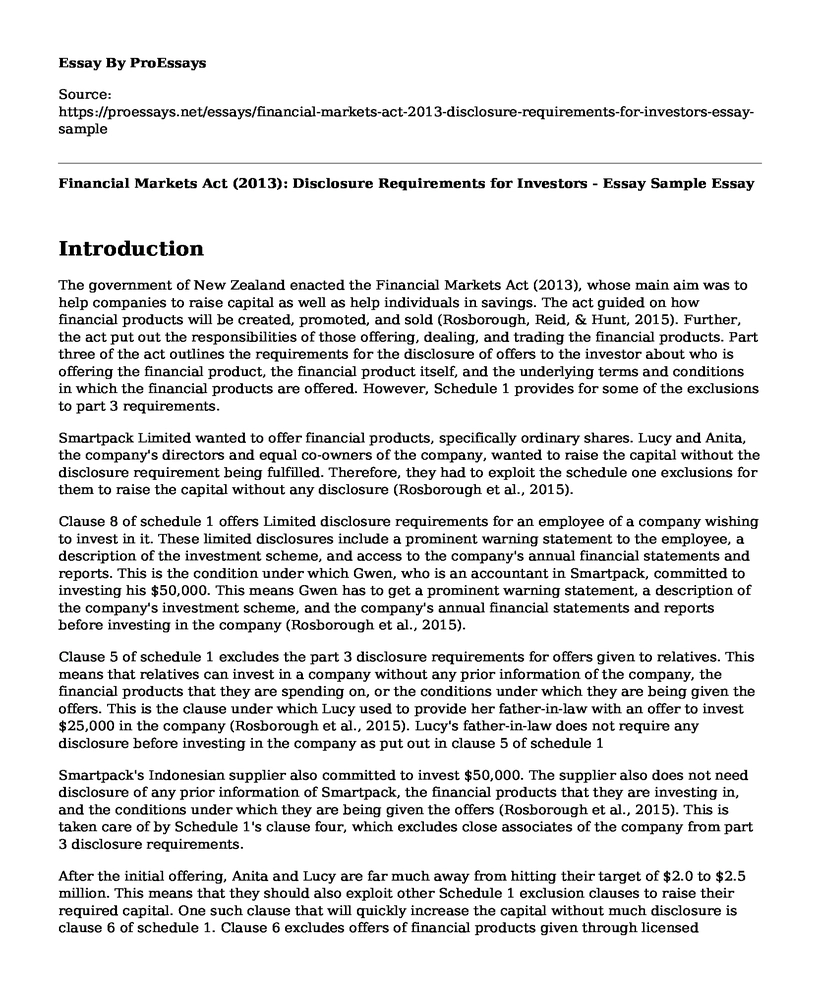Introduction
The government of New Zealand enacted the Financial Markets Act (2013), whose main aim was to help companies to raise capital as well as help individuals in savings. The act guided on how financial products will be created, promoted, and sold (Rosborough, Reid, & Hunt, 2015). Further, the act put out the responsibilities of those offering, dealing, and trading the financial products. Part three of the act outlines the requirements for the disclosure of offers to the investor about who is offering the financial product, the financial product itself, and the underlying terms and conditions in which the financial products are offered. However, Schedule 1 provides for some of the exclusions to part 3 requirements.
Smartpack Limited wanted to offer financial products, specifically ordinary shares. Lucy and Anita, the company's directors and equal co-owners of the company, wanted to raise the capital without the disclosure requirement being fulfilled. Therefore, they had to exploit the schedule one exclusions for them to raise the capital without any disclosure (Rosborough et al., 2015).
Clause 8 of schedule 1 offers Limited disclosure requirements for an employee of a company wishing to invest in it. These limited disclosures include a prominent warning statement to the employee, a description of the investment scheme, and access to the company's annual financial statements and reports. This is the condition under which Gwen, who is an accountant in Smartpack, committed to investing his $50,000. This means Gwen has to get a prominent warning statement, a description of the company's investment scheme, and the company's annual financial statements and reports before investing in the company (Rosborough et al., 2015).
Clause 5 of schedule 1 excludes the part 3 disclosure requirements for offers given to relatives. This means that relatives can invest in a company without any prior information of the company, the financial products that they are spending on, or the conditions under which they are being given the offers. This is the clause under which Lucy used to provide her father-in-law with an offer to invest $25,000 in the company (Rosborough et al., 2015). Lucy's father-in-law does not require any disclosure before investing in the company as put out in clause 5 of schedule 1
Smartpack's Indonesian supplier also committed to invest $50,000. The supplier also does not need disclosure of any prior information of Smartpack, the financial products that they are investing in, and the conditions under which they are being given the offers (Rosborough et al., 2015). This is taken care of by Schedule 1's clause four, which excludes close associates of the company from part 3 disclosure requirements.
After the initial offering, Anita and Lucy are far much away from hitting their target of $2.0 to $2.5 million. This means that they should also exploit other Schedule 1 exclusion clauses to raise their required capital. One such clause that will quickly increase the capital without much disclosure is clause 6 of schedule 1. Clause 6 excludes offers of financial products given through licensed intermediaries (Hillind, 2016). This includes peer-to-peer lending and crowdfunding. Through this strategy, Anita and Lucy can raise to $2 million by offering shares in Smartpack from any investor who is investing small amounts. They can also raise the capital by peer-to-peer lending services by borrowing small amounts of money in exchange for the company's shares as a debt security. This type of offering has no disclosure requirements by the offeror to investors. However, the providers of intermediary service have disclosure requirements and other obligations that should be known by the offeror of the financial products (Christmas, 2015).
Conclusion
In retrospect, the paper has critically evaluated empirical instances surrounding Financial Market Act (2013) in New Zealand. The main aim of the act was to help companies raise capital as well as individuals' savings. The paper creates full emphasis part 3 disclosure requirements are not necessary for any of the investors described in this paper. Rather, it outlines the requirements for the disclosure of offers to the investor based on who is offering, the financial product itself, and the underlying terms and conditions in which the financial products are offered.
References
Christmas, E. P. (2015). Playing to the Crowd? A Critical Analysis of Equity Crowdfunding in the Financial Markets Conduct Act 2013. https://www.otago.ac.nz/law/research/journals/otago715688.pdf
Hillind, H. (2016). Exploiting the crowd: the New Zealand response to equity crowdfunding. Victoria University of Wellington Legal Research Paper, Student/Alumni Paper, (15). https://papers.ssrn.com/sol3/papers.cfm?abstract_id=2779896
Rosborough, L., Reid, G., & Hunt, C. (2015). A primer on New Zealand's capital markets. The Reserve Bank of New Zealand Bulletin, 78(3), 3. https://www.questia.com/library/journal/1G1-415325206/a-primer-on-new-zealand-s-capital-markets
Cite this page
Financial Markets Act (2013): Disclosure Requirements for Investors - Essay Sample. (2023, Jun 07). Retrieved from https://proessays.net/essays/financial-markets-act-2013-disclosure-requirements-for-investors-essay-sample
If you are the original author of this essay and no longer wish to have it published on the ProEssays website, please click below to request its removal:
- Paper Example on Possible Economic and Long-Term Impact of Cryptocurrencies
- Bitcoin and Its Controversies Essay
- Digital Finance in Nigeria Paper Example
- Article Analysis Essay on Are You a Robot
- Is T-Mobile a Good Investment? - Research Paper
- Research Paper on Aaron Burr's Role in Passing 12th Amendment to US Constitution
- Essay Example on Decolonization and Cold War: The New Phase of Imperialism







